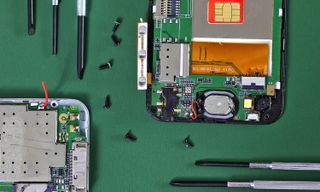Cell phone insurance plans compared: What's worth it?
Sometimes a case isn't enough. We break down phone insurance options from manufacturers, carriers and third-party services to help you make the best choice.
Updated Jan. 9: Verizon is increasing the monthly pricing for its Total Mobile Protection to $13, up from $11. The change accompanies lower deductibles, and will take effect beginning Jan. 25 for new subscribers and March 6 for existing ones.
Smartphones are at the center of our lives. And given all the data stored inside — everything from our contacts and appointments to photos and songs — if anything happens to your phone, it can really disrupt your life. That includes those times when your smartphone gets lost, stolen or damaged.

Mobile-phone insurance is meant to help you during a phone crisis, regardless of what hardship impacts your device. But like any other type of insurance, it will cost you. Many consumers forgo the extra monthly payments of insurance and hope that they don't become one of the 35 percent who break or damage their devices within the first year.
Is that a smart decision? Or is mobile-phone insurance really worth the extra money? Here's some info to consider if you're mulling over insuring your device.
Who should get phone insurance?
Why you can trust Tom's Guide
If you’ve been living without phone insurance and have never had a problem, you might think it’s a waste. After all, if everything’s been going well up to this point, why pay hundreds of dollars on a solution you might never need?
MORE: Best Smartphones - Here Are the 10 Best Phones Available
But the truth is, that’s probably a bad attitude to have. It only takes one drop to make you wish you had smartphone insurance. And if you’re especially prone to slippery fingers, it’s a must-have.

Many people today buy expensive smartphones, like the iPhone 8 or the Samsung Galaxy Note 8. And when they do, they’re opening themselves up to the possibility of spending a significant sum on fixes to their damaged devices. An iPhone 8, for instance, can cost $699. A broken screen out of warranty can cost you $129 ($149 for the iPhone 8 Plus and $279 for an iPhone X). Insurance immediately becomes worth it after just one incident.
It can be confusing to sort through the many mobile-phone insurance plans available, not to mention all of the fine print and fees you'll have to pay over the lifetime of your smartphone.
Below, we break down the most popular insurance plans from manufacturers, wireless carriers and third parties to see how much protection you're really buying, and if it's worth the extra money.
I. AppleCare+ vs. Samsung Premium Care
Let's look at the cost of insuring an iPhone 8. The iPhone 8 will cost you $699 to start. You can go directly to Apple to insure an iPhone 8 Plus or older and buy AppleCare+ for $129, but you must do so within the first 30 days of your purchase. AppleCare+ for an iPhone X is $199. Every iPhone comes with a standard one-year warranty from Apple, but adding AppleCare+ extends that warranty to two years. Note that this plan isn't all-inclusive. For two years, Apple will cover accidental damage (think dropping your phone or spilling water on it) and wear-and-tear, and provide up to two replacement devices.
Apple vs. Samsung Comparison (over 24 months)
| Manufacturer Plan | Protection Plan Cost | Cost per Claim | Total (assuming 1 claim) |
|---|---|---|---|
| AppleCare+ | $129 or $199 | $99 | $228 or $298 |
| Samsung Premium Care | $144 | $99 | $243 |
For both of these replacement claims, you will be charged a $99 service fee plus tax. So contrary to popular belief, your replacement phone under AppleCare+ will not be free. It's also important to note that AppleCare+ doesn't cover theft.
MORE: Best iPhone 8 Cases
What about Android phones, like the $930 Samsung Galaxy Note 8? Similar to Apple's protection plan, you can add Samsung Premium Care to the latest Samsung smartphones (including the Galaxy S8, Galaxy S8+, and Galaxy Note 8) in addition to a carrier's warranty. Samsung Premium Care extends the original one-year warranty to two years, and covers accidental damage, and operational or mechanical breakdowns. You also get in-person support, but you can pay for it in monthly payments of $11.99 rather than pay one lump sum. Like AppleCare+, Premium Care doesn't protect your smartphone if it gets lost or stolen.
II. Wireless Carrier Protection Programs
Phone insurance plans offered by carriers such as AT&T, Sprint, T-Mobile and Verizon typically follow the same pattern: a monthly fee, a deductible for certain claims you make and an equipment limit per claim. Here's a look at the costs across each big carrier, followed by detailed descriptions of each company's program.
Carrier Comparison (over 24 months)
Apple iPhone 8 or Samsung Galaxy S8
| Carrier | Protection Plan Cost per Month | Cost per Claim | Total (assuming 1 claim) |
|---|---|---|---|
| AT&T | $9 | $225 | $441 |
| Sprint | $13 | $200 | $512 |
| T-Mobile | $10 | $175 | $415 |
| Verizon | $13 | $89 | $401 |
Apple iPhone X
| Carrier | Protection Plan Cost per Month | Cost per Claim | Total (assuming 1 claim) |
|---|---|---|---|
| AT&T | $9 | $299 | $515 |
| Sprint | $17 | $250 | $658 |
| T-Mobile | $10 | $275 | $515 |
| Verizon | $13 | $149 | $461 |
AT&T Mobile Protection Pack
AT&T offers three protection plans. The cheapest one will cost you $8.99 per month. That will cover your phone for loss, theft, accidental damages and out-of-warranty malfunctions, and it includes next-day replacement of your smartphone.
The higher-end Mobile Protection Pack costs $10.99 per month and adds ProTech support (unlimited expert technical support) and the ability to back up your photos, videos and contacts. The option even includes smartphone locking and erasing. The Multi-Device Protection Pack is best for families. It costs $29.99 per month and covers three devices on your plan and allows for up to six claims per year. All of the other plans allow for two claims per year.
Sprint Total Equipment
Sprint's Total Equipment Protection plan costs $9 per month and protects against loss, theft, and physical and liquid damage. It also comes with automatic backup services for up to 5GB. If you have a higher-end device, however, you’ll need to upgrade to Sprint’s Total Equipment Protection Plus, which costs $13 a month. It comes with all of the same features as the standard option but boosts backup storage to 25GB and includes online device and tech support.
T-Mobile Premium Handset Protection
T-Mobile’s Premium Device Protection costs $12 per month and covers a “premium” smartphone’s loss, breakdown and theft. Pricing varies depending on the device you have.

T-Mobile also throws in Lookout Mobile Security Premium for iPhone owners who subscribe to the service.
If you buy your phone through T-Mobile’s Jump! plan, you pay $12 per month and get everything that Premium Handset Protection offers, in addition to your Jump! upgrades to a new phone.
If you’re not interested in special services — like remote wipe, app scanning, and backup for contacts and photos — you can choose T-Mobile’s standard Device Protection plan, which costs $10 per month.
Earlier this year, T-Mobile announced that AppleCare services are available for all of its Premium Device Protection offerings at no additional charge. It’s the only carrier to offer AppleCare as part of its insurance plan.
Verizon Extended Equipment Coverage
Verizon offers a few protection plans. The simplest option, Extended Warranty, comes with a $3 monthly cost per device. You must enroll in the program within 30 days, and it covers a replacement only if your phone suffers a defect after the manufacturer's warranty has expired.

Verizon’s Wireless Protection Plan costs $7.15 per month and adds coverage for lost, stolen and damaged smartphones. But again, you’ll need to sign up within 30 days of buying your phone. Finally, if you want Verizon’s $13-a-month Total Mobile Protection, you can get all of the advantages of the Wireless Protection Plan and also ensure coverage on a broken handset. For both the Wireless Protection Plan and the Total Equipment Coverage plan, you’ll need to pay a deductible that varies depending on the handset. You’re allowed up to three replacements in a 12-month period, with a maximum claim up to $1,500.
Carrier recommendation
By our calculations, Verizon has the cheapest protection plan of these carriers by far, costing as little as $401 over 24 months to insure an iPhone 8 and Galaxy S8. Similar to the other carriers we researched, Verizon has a pretty thorough plan that protects your smartphone against loss, theft and physical damages. In fact, carrier plans are the only ones we found that protect your smartphone in cases of loss and theft; third-party providers, and some manufacturers, do not.
MORE: Smartphone Buying Guide: 9 Tips for Finding the Right Phone
III. Third-Party Protection Plans
If neither your manufacturer's insurance plan nor your carrier's insurance plan satisfies you, there are third-party insurance providers that can protect your smartphone. One of them, SquareTrade, covers accidental damage due to things like drops and spills, and mechanical malfunctions. It doesn’t, however, cover loss or theft, and you won't receive any technical support .
SquareTrade’s pricing varies depending on your device, and the company charges an annual fee rather than a monthly one. A two-year plan will set you back $129.
Third-Party Provider Comparison (over 24 months)
Apple iPhone 8
| Carrier | Protection Plan Cost | Cost per Claim | Total (assuming 1 claim) |
|---|---|---|---|
| SquareTrade | $129 (24 months) | $99 | $228 |
| Geek Squad | $96 | $150 | $246 |
Samsung Galaxy S8
| Carrier | Protection Plan Cost | Cost per Claim | Total (assuming 1 claim) |
|---|---|---|---|
| SquareTrade | $129 (24 months) | $99 | $228 |
| Geek Squad | $96 | $150 | $246 |
Best Buy’s Geek Squad also gets into the smartphone insurance mix with the company’s Geek Squad Protection. It offers protection for up to two years on everything from drops and spills to battery replacements. You can even transfer the plan to someone else.

The service costs $7.99 per month. If you want loss and theft coverage, you’ll need to pay $10.99 a month for Geek Squad’s Complete Protection, which also includes all of the features in the standard option.
Third-party provider recommendation
Geek Squad and SquareTrade have comparably priced plans over 24 months, but SquareTrade is a better value for protecting your handset. However, though SquareTrade offers a cheaper option, Geek Squad will cover you in the event of theft or loss if you’re willing to pay a bit more.
MORE: The Best iOS Apps You're Not Using (But Should Be)
Our Overall Recommendations
If you decide you want mobile-phone insurance, you should examine the coverage of each plan you're considering and figure out where you want the bulk of your money to go and what you are willing to sacrifice. If you're more likely to drop your smartphone than to misplace it, try to save a few bucks and go with a third-party company such as SquareTrade, which will reduce your overall cost.
However, if you’re a T-Mobile customer, you’ll get a solid deal from the company with both smartphone protection and AppleCare services. And although pricing can be all over the place with wireless carriers, they do offer some of the quicker service in this roundup.
There are reasons to opt for smartphone manufacturers for insurance: They have the tools needed to fix your device, they are experts at addressing problems, and overall, their pricing isn’t too much more than what you’d find in alternative services.
The bottom line: You need to evaluate how much you want to spend, which companies you feel most comfortable with and the trouble you’re most likely to have have with your handset. Are you prone to losing your smartphone? Go with a company that offers theft and loss protection. Are you not so worried about losing your handset but you’re concerned about having easy access to repair professionals? A third-party provider might not be for you. Ultimately, as with any other kind of insurance, smartphone insurance takes some homework.
Sign up to get the BEST of Tom’s Guide direct to your inbox.
Upgrade your life with a daily dose of the biggest tech news, lifestyle hacks and our curated analysis. Be the first to know about cutting-edge gadgets and the hottest deals.
Valentina is Commerce Editor at Engadget and has covered consumer electronics for a number of publications including Tom's Guide, Wired, Laptop Mag and Ars Technica, with a particular focus on wearables, PCs and other mobile tech.

